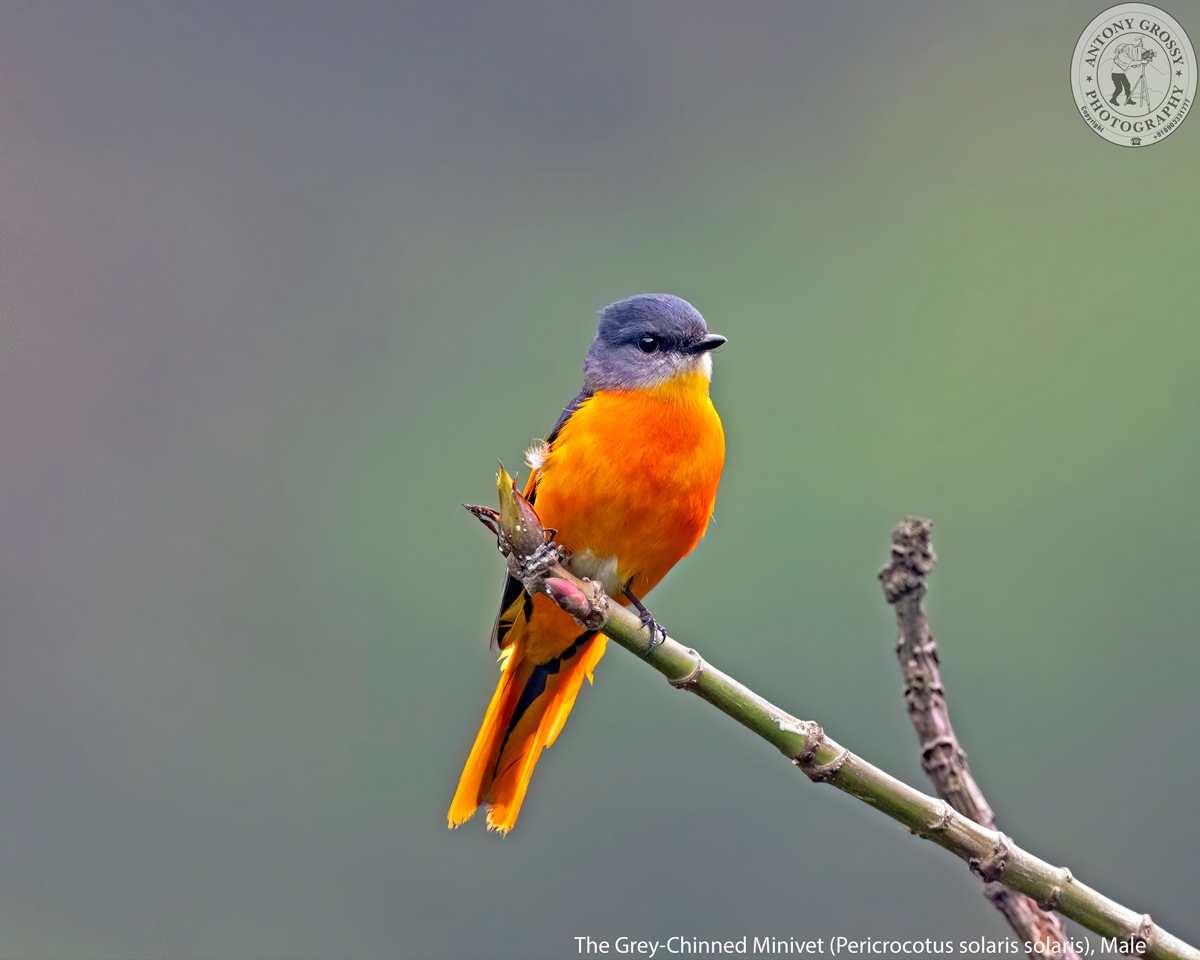

|
 |
| Similar, But Yet So Different – The Grey Chinned Minivet, Male |
| The Grey Chinned Minivet is a small, slim, long-tailed songbird of montane forests, usually vocal, active, and encountered in large flocks. It looks very much similar to the Orange Minivet with the Males having a bright orange belly, but a comma-shaped slash on the wing, a grey head and back and the prominent ear-coverts and cheeks that are ashy grey mark it out. Females are similarly patterned, but have paler upperparts and white throat, with the male’s orange replaced by yellow. Female resembles female Long Tailed Minivet, which has yellow forehead patch, lacking in Grey Chinned Minivet. . . . . . . . . …. ………….. ……………….. .. …. …. ……….. … …. ……….. … …. ………… ………….. ………… ………… ….. ………. …………. …….. ……………. …… …. …. ……….. … …. ……….. .. ………… ….. ………. …………. …….. ……………. … The Grey Chinned Minivet is a slim-bodied and long-tailed songbird that is frequently encountered in large, vocal flocks. Hard to miss, the males have a bright orange-red belly, a comma-shaped slash on the wing, and a grey head and upperparts. It measures between 17 to 19 cm in length and weighs about 11 to 18 gms. This species has marked sexual dimorphism with the male having a top of head and upperparts leaden black, ear-coverts and cheeks ashy grey; upper wing-coverts and remiges blackish, greater coverts tipped scarlet, merging into vermilion band across bases of primaries; central pair of rectrices black, edged vermilion near tip, other rectrices vermilion with black bases; chin pale grey, throat orange; underparts orange-scarlet, thighs grey-black, underwing-coverts orange; iris dark brown; bill and legs black. Distinguished from other red minivets mainly by grey chin and ear-coverts, and by bright colours being more orange than red. The female has black areas replaced by dark grey-brown, lower back, rump and upper tail-coverts greenish yellow, red in wings replaced by yellow, primaries edged whitish towards tips, face side light grey, throat greyish-white, shading into yellow on breast, rest of underparts bright yellow. The eyes, beak and legs are black. The immature bird is similar to the female but has yellow-olive bars on its back. Eight subspecies and the races differ in colouration varies somewhat across the range. . . . . . . . . …. ………….. ……………….. .. …. …. ……….. … …. ……….. … …. ………… ………….. ………… ………… ….. ………. …………. …….. ……………. …… …. …. ……….. … …. ……….. .. ………… ….. ………. …………. …….. ……………. … It is found from the Himalayas to China, Taiwan and South East Asia. In India, this species is distributed in the states of Sikkim, Northmost West Bengal, Assam, Meghalaya and Arunachal Pradesh. Its natural habitat is forests about 1,000 to 2,000 mtrs in elevation. It is mostly found in the canopy of broadleaf forest and also coniferous forest, elfin forest, secondary forest, forest edges and gardens with trees. The artificial ecosystems and habitats of this specie include rural gardens and heavily degraded forests. The natural ecosystems and habitats include tropical and subtropical moist montane forests, broadleaf evergreen forests, tropical and subtropical moist lowland forests and dry deciduous forests. It makes local elevational movements in the Eastern Himalayas, with birds descending to the plains in the non-breeding season. . . . . . . . . …. ………….. ……………….. .. …. …. ……….. … …. ……….. … …. ………… ………….. ………… ………… ….. ………. …………. …….. ……………. …… …. …. ……….. … …. ……….. .. ………… ….. ………. …………. …….. ……………. … The Grey Chinned Minivet is insectivorous and typically found in small groups, which often join larger mixed-species flocks. Diet principally consists mainly of insects. Insects, insect larvae, spiders, beetles and termites are their primary food. Also recorded foraging on the seeds. Forages in the canopy and midstorey, mainly in the terminal foliage. Recorded aerial-sallying after swarming termites. When not breeding, this minivet forms small parties with fewer than 15 individuals and also large flocks of dozens of birds; it sometimes joins mixed-species foraging flocks. It forages for invertebrates in the canopy, sometimes descending to tree ferns or sallying in the air. . . . . . . . . …. ………….. ……………….. .. …. …. ……….. … …. ……….. … …. ………… ………….. ………… ………… ….. ………. …………. …….. ……………. …… …. …. ……….. … …. ……….. .. ………… ….. ………. …………. …….. ……………. … The Grey Chinned Minivet gives a twittering call while feeding, and contact calls include a high-pitched sri-sisi is the main vocalization is a regularly repeated, high-pitched, musical contact call between flock-members, given both when perched and in flight, e.g., tee-ttee-ttee or sri-sisi, as well as an airy chirit-chirit. A short pit, seldom heard or not very conspicuous, repeated a few times. Often in combination with Srisisee calls by other members of the group. Low-pitched twittering notes often heard while foraging. . . . . . . . . . . . . . . . . . . . . . . . . . . . . . . . . . . . . . . . . . . . . . . . …………………….. ………………………………………………………………… ………………………………………………………………………………………………………………………………………………………………………………………….. ………………………………. .. ……… …… … …. ……….. Description Credit Birds of the World (The Cornell Lab), Oiseaux, Birda, Animalia, Nepal Desk, Ogaclicks, Birds of India | Bird World, Bird Count India & Wiki. ……………………………………………………… ………………………………………………………………………………………………………………………………………………………………….. Photo of the Female Posted Earlier – http://www.indianaturewatch.net/displayimage.php?id=666627 |
  |
|
|

























































































































































































































































































































































































































































































































































































































































